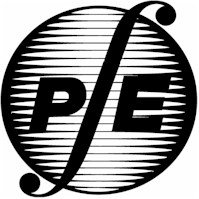Idaho Society of Professional Engineers
Friday Update – 07/13/07
UPCOMING EVENTS:
• July 26 – 29, 2007 –
NSPE 2007 Annual
Conference – Denver, Colorado
• October 26, 2007 -
PE and PS Examinations Boise, Idaho
• October 27, 2007 -
FS (aka LSIT) Examination Boise,
Idaho, Pocatello, Idaho, Moscow, Idaho
• October 27, 2007 -
FE (aka EIT) Examinations Boise,
Idaho, Pocatello, Idaho, Moscow, Idaho
SOMETHING NEW IS COMING TO THE ISPE WEBSITE….
In order to further serve our members, ISPE is adding a
Career Center to our website!
Job Seekers will be able to set up a personal job
seeker account that will allow you to find jobs, manage your resumes, and set up
job alerts. Employers/Recruiters will be able to
post job openings and view resumes. This new feature will be available on the
ISPE website soon, so keep watching for more information!
EDUCATION FOR MEMBERS!
On demand. Online. On Time. Don’t wait until the last minute to get required
PDH’s for your PE license renewal. Members pay only $119 per course. New topics
added regularly.
www.nspe.org/onlinecourses. Questions? Contact Mary Maul at (703) 684-2833.

MATHCOUNTS PROBLEM OF THE WEEK
Can you solve this MATHCOUNTS problem? The answer will appear in next
week's edition of the Friday Update!
Abundant, Deficient or Perfect
Whole numbers are said to be abundant, deficient, or perfect. A whole number is
abundant if the sum of its proper divisors is greater than the whole number. The
whole number 12 is abundant. Its proper factors are 1, 2, 3, 4, and 6 and the
sum of the proper factors is 16 which is greater than 12. A whole number is
deficient if the sum of its proper factors is less than the whole number. The
number 4 is deficient. Its proper factors are 1 and 2 and the sum of its proper
factors is 3 which is less than 4. A whole number is perfect if the sum of its
proper factors is equal to the whole number. The number 6 is perfect. Its proper
factors are 1, 2, and 3 and the sum of its proper factors is 6. This week’s
problems explore the results when abundant, deficient, and/or perfect numbers
are combined in some way.
--------------------------------------------------------------------------------
What is the least possible sum of two distinct abundant numbers that is not an
abundant number?
--------------------------------------------------------------------------------
What is the least possible two-digit sum of two distinct deficient numbers that
is not deficient?
--------------------------------------------------------------------------------
What is the least possible sum of an abundant number and a deficient number that
is not abundant?
--------------------------------------------------------------------------------
What is the least possible abundant number that can be written as the sum of two
abundant numbers in exactly four ways?
Answer to last week’s MATHCOUNTS problem:
The probability of each school drawing a ball labeled with a different day
is the product of the probabilities that each school draws a ball labeled with a
day different from the balls drawn by the preceding schools. The probability for
the first school is 7/7. The probability the second school draws a ball not
drawn by the first school is 6/7. The probability the third school draws a ball
not picked by the first and second school is 5/7. This pattern continues until
the probability the seventh school draws a ball not drawn by the previous six
schools is 1/7. The probability that each school draws a ball labeled with a
different day is (7/7) × (6/7) × (5/7) × (4/7) × (3/7) × (2/7) × (1/7) =
720/117649.
--------------------------------------------------------------------------------
The probability the first school draws the ball labeled Monday is 1/7. The
probability the second school draws the ball labeled Tuesday is 1/6. The
probability the third school draws the ball labeled Wednesday is 1/5. This
pattern continues until the probability the 7th school draws the ball labeled
Sunday is 1/1. The probability the first school draws the ball labeled Monday,
the second school draws the ball labeled Tuesday, and so on so that the next
school to draw a ball draws the ball labeled with the next day in the week until
the seventh school draws the ball labeled Sunday is (1/7) × (1/6) × (1/5) ×
(1/4) × (1/3) × (1/2) × (1/1) = 1/5040.
--------------------------------------------------------------------------------
The probability the first school draws a ball is 7/7. The probability the second
school draws the ball labeled with the same day is 1/7 and that ball is removed.
The probability the third school draws a ball labeled with a different day is
6/6. The probability the fourth school draws the ball labeled with the same day
is 1/6 and that ball is removed. The probability the fifth school draws a ball
labeled with a different day is 5/5. The probability the sixth school draws the
ball labeled with the same day is 1/5 and that ball is removed. The probability
the seventh school draws a ball labeled with a different day is 4/4. The
probability that the days chosen are AABBCCD where A, B, C, and D each represent
a different day is (7/7) × (1/7) × (6/6) × (1/6) × (5/5) × (1/5) × (4/4) =
1/210.
If you want to see last week's problem again, click
http://www.mathcounts.org/webarticles/anmviewer.asp?a=1045&z=110
Idaho Society of Professional Engineers
PO Box 170239
Boise, ID 83717-0239
208-426-0636
Fax: 208-426-0639
E-Mail: ispe@idahospe.org
Web Site: www.Idahospe.org
 Idaho
Society of Professional Engineers
Idaho
Society of Professional Engineers